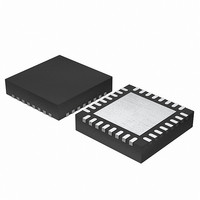EFM32G200F16 Energy Micro, EFM32G200F16 Datasheet - Page 377

EFM32G200F16
Manufacturer Part Number
EFM32G200F16
Description
MCU 32BIT 16KB FLASH 32-QFN
Manufacturer
Energy Micro
Series
Geckor
Datasheets
1.EFM32G200F16.pdf
(63 pages)
2.EFM32G200F16.pdf
(10 pages)
3.EFM32G200F16.pdf
(463 pages)
4.EFM32G200F16.pdf
(136 pages)
Specifications of EFM32G200F16
Core Processor
ARM® Cortex-M3™
Core Size
32-Bit
Speed
32MHz
Connectivity
EBI/EMI, I²C, IrDA, SmartCard, SPI, UART/USART
Peripherals
Brown-out Detect/Reset, DMA, POR, PWM, WDT
Number Of I /o
24
Program Memory Size
16KB (16K x 8)
Program Memory Type
FLASH
Ram Size
8K x 8
Voltage - Supply (vcc/vdd)
1.8 V ~ 3.8 V
Data Converters
A/D 4x12b, D/A 1x12b
Oscillator Type
External
Operating Temperature
-40°C ~ 85°C
Package / Case
32-VQFN Exposed Pad
Processor Series
EFM32G200
Core
ARM Cortex-M3
Data Bus Width
32 bit
Data Ram Size
8 KB
Interface Type
I2C, UART
Maximum Clock Frequency
32 MHz
Number Of Programmable I/os
24
Number Of Timers
2
Operating Supply Voltage
1.8 V to 3.8 V
Maximum Operating Temperature
+ 85 C
Mounting Style
SMD/SMT
Minimum Operating Temperature
- 40 C
Lead Free Status / RoHS Status
Lead free / RoHS Compliant
Eeprom Size
-
Lead Free Status / Rohs Status
Details
- EFM32G200F16 PDF datasheet
- EFM32G200F16 PDF datasheet #2
- EFM32G200F16 PDF datasheet #3
- EFM32G200F16 PDF datasheet #4
- Current page: 377 of 463
- Download datasheet (8Mb)
27 AES - Advanced Encryption Standard Accelerator
27.1 Introduction
27.2 Features
27.3 Functional Description
2010-09-06 - d0001_Rev1.00
The Advanced Encryption Standard (FIPS-197) is a symmetric block cipher operating on 128-bit blocks
of data and 128-, 192- or 256-bit keys.
The AES accelerator performs AES encryption and decryption with 128-bit or 256-bit keys. Encrypting or
decrypting one 128-bit data block takes 54 HFCORECLK cycles with 128-bit keys and 75 HFCORECLK
cycles with 256-bit keys. The AES module is an AHB slave which enables efficient access to the data
and key registers. All write accesses to the AES module must be 32-bit operations, i.e. 8- or 16-bit
operations are not supported.
• AES hardware encryption/decryption
• Efficient CPU/DMA support
• Interrupt on finished encryption/decryption
• DMA request on finished encryption/decryption
• Key buffer in AES128 mode
• Optional XOR on Data write
Some data and a key must be loaded into the KEY and DATA registers before an encryption or decryption
can take place. The input data before encryption is called the PlainText and output from the encryption
is called CipherText. For encryption, the key is called PlainKey. After one encryption, the resulting key
in the KEY registers is the CipherKey. This key must be loaded into the KEY registers before every
decryption. After one decryption, the resulting key will be the PlainKey. The resulting PlainKey/CipherKey
is only dependent on the value in the KEY registers before encryption/decryption. The resulting keys
and data are shown in Figure 27.1 (p. 378) .
0 1 2 3
• 128-bit key (54 HFCORECLK cycles)
• 256-bit key (75 HFCORECLK cycles)
How are you?
4
I am fine
AES
AES
& G# %5
! T4/# 2
...the world's most energy friendly microcontrollers
377
What?
A fast and energy efficient hardware
accelerator for AES-128 and AES-256
encryption and decryption.
Why?
Efficient encryption/decryption with little or
no CPU intervention helps to meet the speed
and energy demands of the application.
How?
High AES throughput allows the EFM32G to
spend more time in lower energy modes. In
addition, specialized data access functions
allow autonomous DMA/AES operation in
both EM0 and EM1.
Quick Facts
www.energymicro.com
Related parts for EFM32G200F16
Image
Part Number
Description
Manufacturer
Datasheet
Request
R

Part Number:
Description:
KIT STARTER EFM32 GECKO
Manufacturer:
Energy Micro
Datasheet:

Part Number:
Description:
KIT DEV EFM32 GECKO LCD SUPPORT
Manufacturer:
Energy Micro
Datasheet:

Part Number:
Description:
BOARD PROTOTYPING FOR EFM32
Manufacturer:
Energy Micro
Datasheet:

Part Number:
Description:
KIT DEVELOPMENT EFM32 GECKO
Manufacturer:
Energy Micro
Datasheet:

Part Number:
Description:
MCU, MPU & DSP Development Tools TG840 Sample Kit
Manufacturer:
Energy Micro
Datasheet:

Part Number:
Description:
MCU, MPU & DSP Development Tools TG Starter Kit
Manufacturer:
Energy Micro
Datasheet:

Part Number:
Description:
MCU, MPU & DSP Development Tools TG108 Sample Kit
Manufacturer:
Energy Micro

Part Number:
Description:
MCU, MPU & DSP Development Tools TG210 Sample Kit
Manufacturer:
Energy Micro
Datasheet:

Part Number:
Description:
MCU, MPU & DSP Development Tools TG822 Sample Kit
Manufacturer:
Energy Micro
Datasheet:

Part Number:
Description:
MCU, MPU & DSP Development Tools TG230 Sample Kit
Manufacturer:
Energy Micro

Part Number:
Description:
SAMPLE KIT (SMALL BOX - CONTAINING 2 DEVICES)
Manufacturer:
Energy Micro

Part Number:
Description:
SAMPLE KIT (SMALL BOX - CONTAINING 2 DEVICES)
Manufacturer:
Energy Micro










